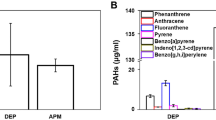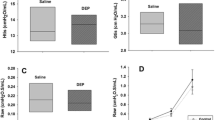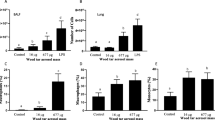Abstract
Air pollution caused by fuel burning contributes to respiratory impairments that may lead to death. We aimed to investigate the effects of biodiesel (DB) burning in mouse lungs. DB particulate matter was collected from the exhaust pipes of a bus engine. Mice were treated with 250 μg or 1000 μg of DB particulate matter by intranasal instillation over 5 consecutive days. We demonstrated that DB particulate matter penetrated the lung in the 250-μg and 1000-μg groups. In addition, the DB particulate matter number in pulmonary parenchyma was 175-fold higher in the 250-μg group and 300-fold higher in the 1000-μg group compared to control mice. The instillation of DB particulate matter increased the macrophage number and protein levels of TNF-alpha in murine lungs. DB particulate matter enhanced ROS production in both exposed groups and the malondialdehyde levels compared to the control group. The protein expression levels of Nrf2, p-NF-kB, and HO-1 were higher in the 250-μg group and lower in the 1000-μg group than in control mice and the 250-μg group. In conclusion, DB particulate matter instillation promotes oxidative stress by activating the Nrf2/HO-1 and inflammation by p-NF-kB/TNF-alpha pathways.







Similar content being viewed by others
References
Krzyzanowski, M., B. Kuna-Dibbert, and J. Schneider. 2005. Health effects of transport-related air pollution. Copenhagen: World Health Organization.
Guarieiro, L.L.N., and A.L.N. Guarieiro. 2013. Vehicle emissions: What will change with use of biofuel? In Biofuels - Economy, Environment and Sustainability, ed. Z. Fang, 357–386. Rijeka: InTech: Open Science, Open Mind.
Mitsakou, C., C. Housiadas, K. Eleftheriadis, S. Vratolis, C. Helmis, and D. Asimakopoulos. 2007. Lung deposition of fine and ultrafine particles outdoors and indoors during a cooking event and a no activity period. Indoor Air 17 (2): 143–152. https://doi.org/10.1111/j.1600-0668.2006.00464.x.
Kleinman, M.T., C. Sioutas, J.R. Froines, E. Fanning, A. Hamade, L. Mendez, D. Meacher, and M. Oldham. 2007. Inhalation of concentrated ambient particulate matter near a heavily trafficked road stimulates antigen-induced airway responses in mice. Inhalation Toxicology 19 (Suppl 1): 117–126. https://doi.org/10.1080/08958370701495345.
Laks, D., R.C. de Oliveira, P.A. de Andre, M. Macchione, M. Lemos, D. Faffe, P.H. Saldiva, and W.A. Zin. 2008. Composition of diesel particles influences acute pulmonary toxicity: An experimental study in mice. Inhalation Toxicology 20 (11): 1037–1042. https://doi.org/10.1080/08958370802112922.
Nemmar, A., S. Al-Salam, P. Yuvaraju, S. Beegam, and B.H. Ali. 2015. Emodin mitigates diesel exhaust particles-induced increase in airway resistance, inflammation and oxidative stress in mice. Respiratory Physiology & Neurobiology 215: 51–57. https://doi.org/10.1016/j.resp.2015.05.006.
Nemmar, A., D. Subramaniyan, S. Zia, J. Yasin, and B.H. Ali. 2012. Airway resistance, inflammation and oxidative stress following exposure to diesel exhaust particle in angiotensin II-induced hypertension in mice. Toxicology 292 (2–3): 162–168. https://doi.org/10.1016/j.tox.2011.12.009.
Yanamala, N., M.K. Hatfield, M.T. Farcas, D. Schwegler-Berry, J.A. Hummer, M.R. Shurin, M.E. Birch, D.W. Gutkin, E. Kisin, V.E. Kagan, A.D. Bugarski, and A.A. Shvedova. 2013. Biodiesel versus diesel exposure: Enhanced pulmonary inflammation, oxidative stress, and differential morphological changes in the mouse lung. Toxicology and Applied Pharmacology 272 (2): 373–383. https://doi.org/10.1016/j.taap.2013.07.006.
Patel, H., S. Eo, and S. Kwon. 2011. Effects of diesel particulate matters on inflammatory responses in static and dynamic culture of human alveolar epithelial cells. Toxicology Letters 200 (1–2): 124–131. https://doi.org/10.1016/j.toxlet.2010.11.007.
Cabral Filho, S., and M. Ramos. 2013. Relatório da Qualidade do ar do Estado do Rio de Janeiro - Ano Base 2010 e 2011. first Aufl. Rio de Janeiro: Instituto Estadual do Ambiente
Brasil. 2014. Lei n° 13.033, de 24 de Setembro de 2014. 1 Aufl. Brasília: Diário Oficial da União.
Wallington, T.J., J.E. Anderson, E.M. Kurtz, and P.J. Tennison. 2016. Biofuels, vehicle emissions, and urban air quality. Faraday Discussions 189: 121–136. https://doi.org/10.1039/c5fd00205b.
Bates, J.H., A. Rossi, and J. Milic-Emili. 1985. 1985. Analysis of the behavior of the respiratory system with constant inspiratory flow. Journal of Applied Physiology 58 (6): 1840–1848.
Choi, H.S., J.W. Kim, Y.N. Cha, and C. Kim. 2006. A quantitative nitroblue tetrazolium assay for determining intracellular superoxide anion production in phagocytic cells. Journal of Immunoassay & Immunochemistry 27 (1): 31–44. https://doi.org/10.1080/15321810500403722.
Draper, H.H., and M. Hadley. 1990. Malondialdehyde determination as index of lipid peroxidation. Methods in Enzymology 186: 421–431.
Romana-Souza, B., J.S. Santos, and A. Monte-Alto-Costa. 2009. Beta-1 and beta-2, but not alpha-1 and alpha-2, adrenoceptor blockade delays rat cutaneous wound healing. Wound Repair and Regeneration 17 (2): 230–239. https://doi.org/10.1111/j.1524-475X.2008.00453.x.
Mazzoli-Rocha, F., C.B. Magalhaes, O. Malm, P.H. Saldiva, W.A. Zin, and D.S. Faffe. 2008. Comparative respiratory toxicity of particles produced by traffic and sugar cane burning. Environmental Research 108 (1): 35–41. https://doi.org/10.1016/j.envres.2008.05.004.
Zin, W.A., A.G. Silva, C.B. Magalhaes, G.M. Carvalho, D.R. Riva, C.C. Lima, J.H. Leal-Cardoso, et al. 1985. 2012. Eugenol attenuates pulmonary damage induced by diesel exhaust particles. Journal of Applied Physiology 112 (5): 911–917. https://doi.org/10.1152/japplphysiol.00764.2011.
Gowdy, K., Q.T. Krantz, M. Daniels, W.P. Linak, I. Jaspers, and M.I. Gilmour. 2008. Modulation of pulmonary inflammatory responses and antimicrobial defenses in mice exposed to diesel exhaust. Toxicology and Applied Pharmacology 229 (3): 310–319. https://doi.org/10.1016/j.taap.2008.01.040.
Sunil, V.R., K.J. Patel, G. Mainelis, B.J. Turpin, S. Ridgely, R.J. Laumbach, H.M. Kipen, Y. Nazarenko, M. Veleeparambil, A.J. Gow, J.D. Laskin, and D.L. Laskin. 2009. Pulmonary effects of inhaled diesel exhaust in aged mice. Toxicology and Applied Pharmacology 241 (3): 283–293. https://doi.org/10.1016/j.taap.2009.08.025.
Kafoury, R.M., and M.C. Madden. 2005. Diesel exhaust particles induce the over expression of tumor necrosis factor-alpha (TNF-alpha) gene in alveolar macrophages and failed to induce apoptosis through activation of nuclear factor-kappaB (NF-kappaB). International Journal of Environmental Research and Public Health 2 (1): 107–113.
Takizawa, H., T. Ohtoshi, S. Kawasaki, T. Kohyama, M. Desaki, T. Kasama, K. Kobayashi, et al. 1999. Diesel exhaust particles induce NF-kappa B activation in human bronchial epithelial cells in vitro: Importance in cytokine transcription. Journal of Immunology 162 (8): 4705–4711.
Durga, M., S. Nathiya, A. Rajasekar, and T. Devasena. 2014. Effects of ultrafine petrol exhaust particles on cytotoxicity, oxidative stress generation, DNA damage and inflammation in human A549 lung cells and murine RAW 264.7 macrophages. Environmental Toxicology and Pharmacology 38 (2): 518–530. https://doi.org/10.1016/j.etap.2014.08.003.
Nemmar, A., S. Al-Salam, S. Zia, S. Dhanasekaran, M. Shudadevi, and B.H. Ali. 2010. Time-course effects of systemically administered diesel exhaust particles in rats. Toxicology Letters 194 (3): 58–65. https://doi.org/10.1016/j.toxlet.2010.02.001.
Chan, J.K., J.G. Charrier, S.D. Kodani, C.F. Vogel, S.Y. Kado, D.S. Anderson, C. Anastasio, and L.S. Van Winkle. 2013. Combustion-derived flame generated ultrafine soot generates reactive oxygen species and activates Nrf2 antioxidants differently in neonatal and adult rat lungs. Particle and Fibre Toxicology 10: 34. https://doi.org/10.1186/1743-8977-10-34.
Kensler, T.W., N. Wakabayashi, and S. Biswal. 2007. Cell survival responses to environmental stresses via the Keap1-Nrf2-ARE pathway. Annual Review of Pharmacology and Toxicology 47: 89–116. https://doi.org/10.1146/annurev.pharmtox.46.120604.141046.
Deng, X., W. Rui, F. Zhang, and W. Ding. 2013. PM2.5 induces Nrf2-mediated defense mechanisms against oxidative stress by activating PIK3/AKT signaling pathway in human lung alveolar epithelial A549 cells. Cell Biology and Toxicology 29 (3): 143–157. https://doi.org/10.1007/s10565-013-9242-5.
Funding
This study was supported by the Carlos Chagas Filho Foundation for Research Support in the State of Rio de Janeiro (FAPERJ, grants E-26/103.184/2011 and E-26/110.294/2014) and Brazilian Council for Scientific and Technological Development (CNPq, grants 300531/2012-5 and 470495/2012-0).
Author information
Authors and Affiliations
Corresponding author
Rights and permissions
About this article
Cite this article
Cattani-Cavalieri, I., Valenca, S.S., Lanzetti, M. et al. Acute Exposure to Diesel-Biodiesel Particulate Matter Promotes Murine Lung Oxidative Stress by Nrf2/HO-1 and Inflammation Through the NF-kB/TNF-α Pathways. Inflammation 42, 526–537 (2019). https://doi.org/10.1007/s10753-018-0910-8
Published:
Issue Date:
DOI: https://doi.org/10.1007/s10753-018-0910-8




